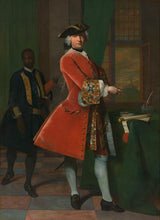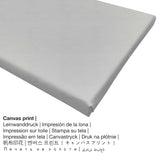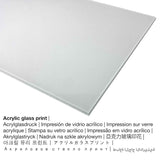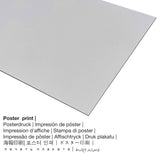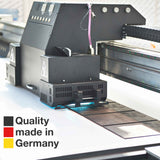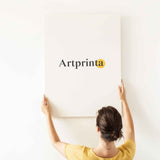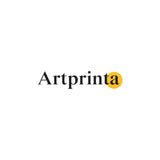Frans van der Mijn, 1742 - Foto nke Jan Pranger - mbipụta nka mara mma
Ụtụ gụnyere. Mbupu gbakọrọ na ndenye ọpụpụ.
Things you should know about the art replica of the painting "Portrait of Jan Pranger"
Na 1742 na Dutch artist Frans van der Mijn tee ihe a nka ochie artpiece. It is in the the collection of Rijksmuseum, nke dị na Amsterdam, Netherlands. Site n'ikike nke - Rijksmuseum (ikike - ngalaba ọha).Na mgbakwunye na nke ahụ, ọrụ nka nwere akara kredit ndị a: . Nhazi ahụ bụ Eserese na nwere akụkụ ruru nke 1: 1.4, nke pụtara na ogologo bụ 29% mkpụmkpụ karịa obosara.
Original artwork description from the museum's website (© Copyright - by Rijksmuseum - Rijksmuseum)
Jan Pranger was director-general of the Dutch West India Company on the Gold Coast (now Ghana) in West Africa from 1730 to 1734. Here he is seen standing in his office in the Dutch trading post Fort Elmina. All the details underscore the importance of his position: the house slave with the parasol, the commander’s baton, and the monogram GWC (of the Chartered West India Company) on the tablecloth.
Ozi ọrụ nka
| Aha nka: | "Portrait of Jan Pranger" |
| Nhazi nka: | sere |
| Otu sara mbara: | nka ochie |
| Narị afọ nka: | 18th narị afọ |
| Emepụtara na: | 1742 |
| Afọ nka: | karịa afọ 270 |
| Ụlọ ihe ngosi nka / ebe: | Rijksmuseum |
| Ebe ngosi nka: | Amsterdam, Netherlands |
| Ebe nrụọrụ weebụ ihe ngosi nka: | www.rijksmuseum.nl |
| Akwụkwọ ikike nka: | ngalaba ọha |
| Site n'aka: | Rijksmuseum |
Data omenka ahaziri ahazi
| Aha onye nka: | Frans van der Mijn |
| Aha utu aha: | Mijn Frans van der, Franz von der Meyn, Frans Van Der Mijn, F. Vander Myn, Myn Frans van der, Franciscus van der Myn, Myn Franciscus van der, F. D. Myn, Franz van Myn |
| okike nke onye nka: | nwoke |
| Obodo onye nka: | Dutch |
| Ọrụ: | onye na-ese ihe |
| Obodo obibi: | mba netherland |
| Otu nka: | nna ukwu ochie |
| Akwụsị: | 65 afọ |
| A mụrụ: | 1718 |
| Obodo: | Antwerp, Antwerpen n'ógbè, Flanders, Belgium |
| Afọ nwụrụ: | 1783 |
| Nwuru na (ebe): | London, Greater London, England, United Kingdom |
Ihe di
N'ime ndetu ndetu dị n'akụkụ ngwaahịa a, ị nwere ike họrọ ngwa na nha nke gị. Ka ị kwekọọ n'ihe ị chọrọ nke ọma, ị nwere ike họrọ n'ime nhọrọ nhazi ngwaahịa ndị a:
- Mpempe akwụkwọ ederede (akwa akwa akwa): Our poster print is a printed sheet of canvas with a fine structure on the surface, which reminds the actual masterpiece. A print poster is perfectly suited for framing your art print with a customized frame. Please keep in mind, that depending on the size of the canvas poster print we add a white margin of approximately 2-6cm round about the artwork to facilitate the framing.
- Aluminom dibond (ọkpụkpụ ọla): Aluminium Dibond prints are prints on metal with a true depth - for a modern look and a non-reflective surface. A direct Aluminium Dibond Print is your perfect introduction to the sophisticated world of art replicas on aluminum.
- Kwaaji: A printed canvas, not to be mistaken with a painting on a canvas, is a digital replica printed on an industrial printer. What is more, canvas generates a cosy and warm atmosphere. How can I hang a canvas print on my wall? The advantage of canvas prints is that they are relatively low in weight, which implies that it is easy and straightforward to hang your Canvas print without additional wall-mounts. A canvas print is suited for any kind of wall.
- Ugogbe acrylic ebipụtara: A glossy acrylic glass print, often described as a plexiglass print, will turn your favorite original into gorgeous décor and offers a viable alternative to canvas and dibond prints. The work of art is custom-made with the help of state-of-the-art UV printing technology. This makes vibrant and stunning color shades. The major advantage of a plexiglass print is that contrasts plus color details become more recognizeable with the help of the delicate tonal gradation. Our acrylic glass protects your custom fine art print against light and external influences for between 40-60 years.
Ozi ederede
| Nkewa ngwaahịa: | ọrụ mgbidi |
| Mmeputakwa: | dijitalụ mmeputakwa |
| Usoro nhazi: | Mbipụta UV / dijitalụ |
| Mmalite ngwaahịa: | emepụtara na Germany |
| Ụdị ngwaahịa: | mmepụta ihe na-achọ |
| Ojiji ngwaahịa: | ụlọ mmepụta ihe nka, mgbidi gallery |
| Ndepụta: | nhazi ihe osise |
| Ụdị anya: | (ogologo: obosara) 1: 1.4 |
| Ntụgharị nkọwa akụkụ akụkụ: | ogologo bụ 29% mkpụmkpụ karịa obosara |
| Ihe mmeputakwa dị: | Mpempe iko acrylic (nke nwere ezigbo mkpuchi iko), mbipụta ọla (aluminium dibond), mbipụta akwụkwọ mmado (akwụkwọ kwaaji), mbipụta kwaaji. |
| Nha n'arọwa n'elu ihe ndọtị (mbipụta akwa akwa): | 50x70cm - 20x28", 100x140cm - 39x55" |
| Mbipụta iko acrylic (nke nwere ezigbo mkpuchi iko): | 50x70cm - 20x28", 100x140cm - 39x55" |
| Mpempe akwụkwọ mmado (akwụkwọ kwaaji) nha dị iche iche: | 50x70cm - 20x28" |
| Mbipụta aluminom (ihe alumini debond ihe): | 50x70cm - 20x28", 100x140cm - 39x55" |
| Igwe onyonyo: | mbipụta nka na-enweghị isi |
Ederede iwu dị mkpa: We try what we can in order to describe the art products as clearly as possible and to showcase them visually on the various product detail pages. Nonetheless, the tone of the printed materials and the imprint may differ to a certain extent from the image on your monitor. Depending on your settings of your screen and the quality of the surface, colors might not be printed as realisitcally as the digital version depicted here. Given that all fine art prints are processed and printed by hand, there may as well be slight discrepancies in the motif's size and exact position.
© Nwebiisinka nke | www.artprinta.com (Artprinta)

